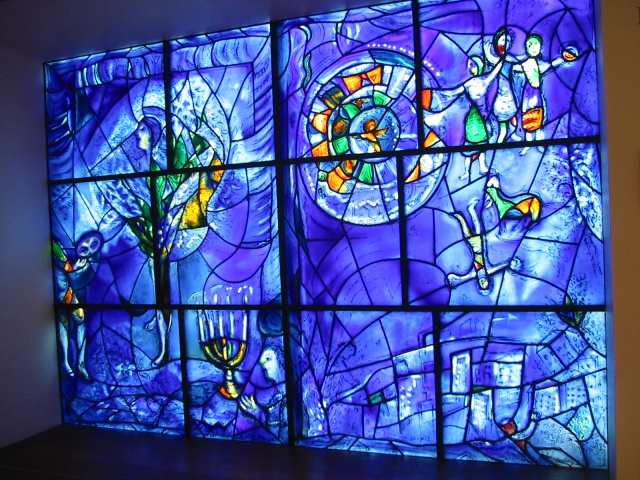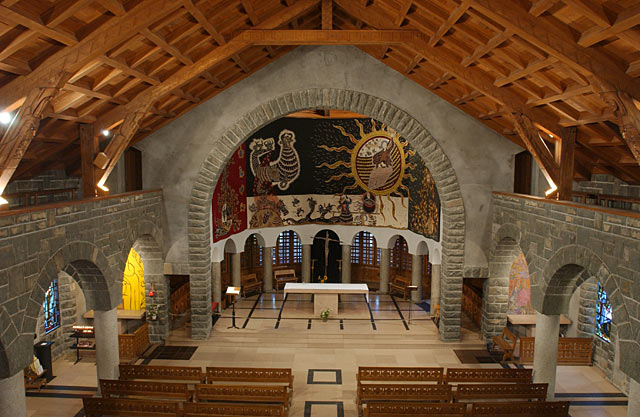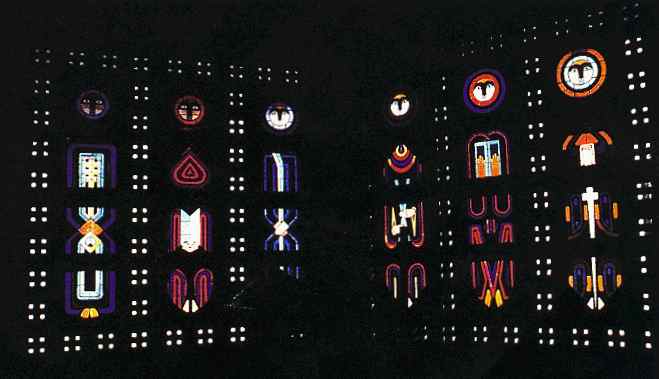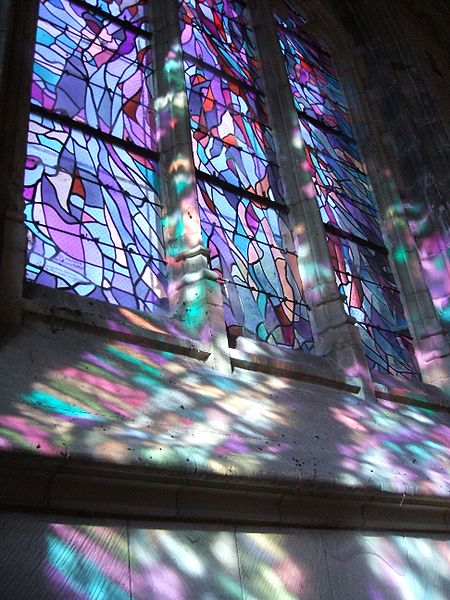For a long time it was assumed that only medieval artists and craftsmen were capable of creating great art in stained glass. It was said that though there world was even darker, their faith shone more vividly than ours. Though the technique remains largely traditional, the design of modern stained glass has radically broken with tradition. The medium, with its resolute outlines and barbaric richness of color , invites the bold form of modern expression. Yet, the message can also be spiritual and often as moving as the gothic images.

---My strongest past experience with Chagall has been seeing his amazing stained glass windows at the Art Institute in Chicago. They were so visceral and alive. I remember thinking "Why isn't everything this beautiful? Why don't we live in a society that makes art part of our every day existence?" After that when I thought of Chagall I felt happy. I thought of color and light and floating. I just love the dreamlike quality in his work.--- Read More:http://nerdfighters.ning.com/profiles/blogs/art-of-the-month-marc-chagall
Stained glass first appeared in the cathedrals of Augsburg and Le Mans some nine hundred plus years ago. It was a sudden birth in full-blown glory. There seems to have been no gradual evolution of the art, no prelude. Glass, of course, and colored glass as well, had been used for centuries before. But a pictorial design of colored glass, a translucent mosaic as it were, seems to have been the instant inspiration of an unknown genius. And it, in turn, helped to inspire new structures that strove to accommodate larger and larger expanses of stained glass.
The decline of the art began when the mystic semi-darkness of the Gothic cathedrals gave way to the Renaissance light of learning and humanism. Though the Renaissance masters still created stain glass windows, they regarded them as huge transparent canvases on which they painted in more elaborate technique and ever lighter hues, but with lessened emotional impact. Fortunately, it was a nineteenth-century change in taste that helped the craft to survive: the Gothic revival.

---. Sacred Heart Catholic Church, Audincourt, France, 1952, Interior, Architect Maurice Novarina, 1907-2002. 70 meters of glass windows above the altar depicting the passion of Christ Fernand Leger, 1881-1955 artist of the stained glass windows Christian art and symbolism. Fr. John Domin, photographer Paula Hamilton, compiler.---Read More:http://sanctuaryforsacredarts.com/S4SAGallery/displayimage.php?album=5&pos=35
Stained glass began an revival in earnest after WWII with the need to rebuild the churches destroyed or damaged. There were four thousand in France alone. Behind the drive of Father Couturier, somewhat controversial on theologic and aesthetic grounds, his influence of modern liturgical art was strongly felt throughout the West. One of its fruits was the rejuvenation of stained glass.

---Novarina Maurice (architecte) ; Rouault Georges (peintre) ; Bonnard Pierre (peintre) ; Huré Marguerite (maître verrier) ; Lurçat Jean (peintre) ; Bazaine Jean (peintre) ; Richier Germaine (sculpteur) ; Léger Fernand (peintre) ; Matisse Henri (peintre) ; Braque Georges (peintre) ; Demaison C. (sculpteur) ; Chagall Marc (peintre) ; Lipchitz Jacques (peintre) ; Signori (sculpteur) ; Kijno L. (peintre) ; Mary C. (sculpteur) ; Stravinsky T. (peintre) ; Couturier M.-A. (peintre) ; Hébert-Stevens A. (maître verrier) ; Bony P. (maître verrier), Berçot P. (peintre) ; Brianchon M. (peintre) ; Coignard B. (sculpteur)--- Read More:http://www.culture.gouv.fr/rhone-alpes/label/spip.php?article30
Marc Chagall was one of the post-war stained glass artists, known primarily for his blazing windows in Jerusalem. He ingeniously used black cames and heavy bars to denote the semi-abstract design of his animals and objects and to emphasize the brilliance of his colors. To add detail, he followed the medieval practice of painting on the glass with a brownish enamel , called grisaille, before refiring in the kiln. To shade his colors, Chagall borrowed still another technique from the Middle Ages: the use of flashed glass, which consists of thin film fused together. Layer by layer the films are then chipped, ground, or eaten away by acid.

---Designed by Wallace K. Harrison, the new sanctuary was dedicated in March 1958. Its shape has been likened to that of a fish- a symbol used in early Christianity. The fish shape is apparent both in the profile and in the floor plan of the structure. Enhancing the unique shape of the church are the outstanding stained glass windows in the sanctuary, containing more than 20,000 pieces of faceted glass and depicting the story of the Crucifixion and of the resurrection; and the 32 foot high cross faced with wood from the Canterbury Cathedral in England, which dominates the Chancel.---Read More:http://www.agoevents.org/2010/poe/region-1/venues/fish-church
What became the biggest religious building boom ever, caused by the devastation of WWII in Europe gave the most impetus to the revival. That, and the modern church architecture that arose since its radical break with tradition seemed to demand new forms of artistic expression. Or, was it the artists themselves who insisted on bringing their color and emotion to these cold, monochromatic structures? “Give me wall
8221; the painter Leger, tired of confining canvases, had cried in the thirties…..
Church of St. Remy at Baccarat. nicolas kazis. ----Jason Peter Brown:And yet, ironically enough, the recovery of colour and light as dynamic aspects of the medium has been due, in large part, to the efforts of 20th c. painters and architects. In the 19th century, pre-modern Gothic revivalists like Ruskin in Britain and architect Viollet LeDuc in France sought to understand the optical mysteries of medieval glaziers' colour use, just as scientists like Helmholtz, Maxwell, Chevreul and Rood were attempting to unravel the complexities of colour related to human perceptual faculties. Art Nouveau artists and architects (Clarke, MacIntosh, Horta, Guimard, Gaudi, Tiffany, to name only a few) experimented with glass as an architectural design element, and in some cases explored its richly emotive colour capacity. Read More:http://www.aisg.on.ca/articles/6d1a97f458d6b16a4b18bff41c23fe595725e6b7.html






 COMMENTS
COMMENTS